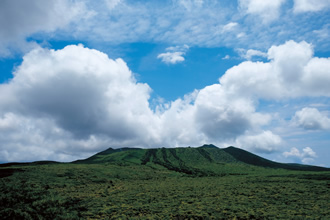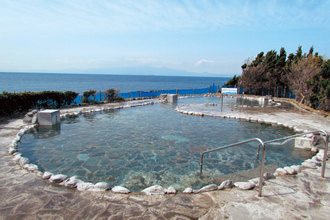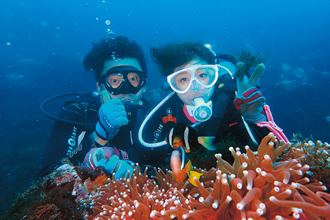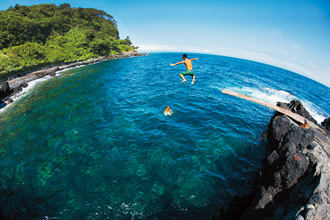niponica is a web magazine that introduces modern Japan to people all over the world.
2017 No.22
 Strolling Japan
Strolling Japan
The Tokyo Metropolis is on Honshu, but it also includes 13 inhabited islands, including the Izu Islands and Ogasawara Islands, in the Pacific Ocean. The biggest of these islands is Oshima, a treasure trove of nature crowned by Mt. Mihara, an active volcano. It takes only one hour and 45 minutes by high-speed ferry to experience a whole different side of Tokyo.
Photos: Kohara Takahiro

Oshima Island measures about 9 kilometers east to west, about 15 kilometers north to south. It is a treasure trove of nature, so you can enjoy various fun activities. (Photo: amanaimages)
The ferry races under Rainbow Bridge, skimming over the water. After it passes Yokosuka Port and the Boso Peninsula, an onboard announcement tells us we have entered the natural habitat of large ocean mammals. Here, migrating dolphins can be seen, and we learn we might have a chance to spot a sperm whale.
Oshima is the largest of the Izu Islands, although it measures only about 9 kilometers east to west and about 15 kilometers north to south. It takes less than two hours to drive around the island. The 8,300 people who live on Oshima tend to take life easy, except when the regularly scheduled boats arrive in the harbor. Then the pace quickens for tourists, locals and businesspeople alike. Visitors are especially numerous in the summer, when the sea is a popular destination, and in the winter, when many visit for the Izu Oshima Camellia Festival. At other times of the year pleasure seekers come for ocean action, especially fishing, diving and snorkeling.
The last few years have seen a growing number of tourists attracted by the abundant nature on this aptly nicknamed “Active Volcano Island.” Since ancient times the islanders have venerated Mt. Mihara as a kind of god, and today highland hiking is one way for visitors to complete their island experience.
The trail around the crater opened in 1998, and in 2010 the area was designated as one of the Japanese Geoparks, natural parks highlighting geological heritage. Join a group led by a certified geoguide to enhance your tour with information on the volcano, lava and local plants and animals. From the mountain lookout, which is accessible by car and located at the trailhead to the summit, you will see Mt. Mihara and part of the large caldera that was formed about 1,700 years ago. Turn around and look northwest—when the weather cooperates, Mt. Fuji is visible across the ocean. If you go further, for about 45 minutes on foot, you will come to an awesome crater measuring about 300 meters across and plummeting about 200 meters down. To the south lie the Izu Islands, to the northeast the Boso Peninsula, and to the northwest the Izu Peninsula with Mt. Fuji beyond it. The hike with all these in view is a memorable experience that makes you feel you have set out to explore the planet.
This scenic open air spa is called Motomachi Hama-no-Yu. Soak in the bath with the sea before your eyes.
Thanks to the influence of a warm current, divers come across all kinds of marine life around Oshima Island.
(Photos: Global Nature Club ft. Umisamurai)











